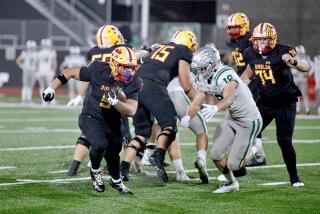CIF Seeks to Reward Top Teams : Football Champions, Seeded Teams Would Get 3 Home Games
- Share via
Proposals that would guarantee home games through the first three rounds of the postseason playoffs to league football champions and to the top four seeded teams in each conference were introduced Thursday in a Southern Section general council meeting in Norwalk.
Jerry Witte, the Saddleback High School coach and a member of the section’s football advisory committee, introduced the measures to representatives of the 64 leagues that make up the Southern Section.
The proposals were discussion items that will be voted upon in the next general council meeting, scheduled for Jan. 21. A simple majority vote is all that is necessary to pass either item. If passed, the proposals would go into effect in the 1988 season.
The first proposal would guarantee a league’s No. 1 designated team a home field advantage until the championship game in the playoffs--provided, of course, that it survives.
The second proposal would offer the same guarantee of home games to the top four seeded teams. Teams are seeded by the section’s playoff committee before the announcement of the playoff pairings.
Such a proposal, if approved, would ensure a school such as El Toro and Capistrano Valley, rated first and second in Orange County and each a member of the South Coast League, of having the home field advantage even if it finished second in a league race.
“The general feeling was that schools should be rewarded for being a league champion or a seeded team,” Witte said. “It’s based on the same formula that the National Football League uses to determine its champion.”
An exception to the proposal would have to be made when league champions meet head-to-head in subsequent rounds of the playoffs. Eight of the nine conferences in the Southern Section consist of five leagues, and the Inland Conference has six leagues.
“Rewarding the league champion is an interesting concept, but it has a big flaw,” said Ted Mullen, Anaheim coach, who led teams at Villa Park and Foothill. “There’s five teams in most of the conferences. Who’s going to be the odd man out when it comes time for No. 1 to play No. 1?
“You often get an upset in the first round that changes things dramatically. My feeling is that if you upset a No. 1 team in the first round, you deserve a home game the next week. I’ve been in five title games, and I think those teams won the league title only twice.”
Mike Milner, Fountain Valley coach, questioned the financial feasibility of the proposal. He pointed out that the Southern Section takes 50% of the gate receipts from all playoff games and the revenue is a major income for the section.
“What happens if a league champion or seeded team is perennially a bad drawing team and it gets three straight home games?” he said. “There are some good football teams that play in poor facilities or just don’t draw that many fans.
“You have to look at the playoffs from a financial aspect. I think the CIF should be interested in holding its playoff games in good stadiums generally hosted by teams that draw well.”
Last year, of the section’s total income of $930,320, $346,138 came from its football playoffs. The section has budgeted $341,000 for playoff revenue this year.
Greg Shadid, who led Bolsa Grande to the Central Conference title last year, showed that an unseeded team can win a championship, but he conceded that a little luck helped the Matadors.
“We weren’t seeded, but we were the home team in three of our four playoff games,” he said. “My biggest concern is always with the facility that we have to play in when we’re on the road. That should be a big priority with the CIF, too, since it’s getting half the gate.”
Many small school representatives immediately voiced displeasure with the proposals.
Representatives from the Inland Conference, which includes the Olympic League, questioned a possible increase in travel expenses. Orange Lutheran, Southern California Christian and Whittier Christian are members of the Olympic League.
The Inland Conference includes schools as geographically distant as Mammoth, Santa Ynez and Trona among its 37 members.
“It would seem that the small schools would have the biggest travel disadvantage under this proposal, and we’re the ones that can least afford increased expenses,” said Dean Anders, principal of Santa Ynez High.
Under the present playoff pairing system, a league champion is guaranteed a home game in the first round and then must travel in the second round if it faces a team that was on the road in the first round. In the event both teams had home games in the first round, a coin flip determines who gets the home game in the second round.
“The bottom line is that three home games just wouldn’t be fair,” Mullen said. “The status quo is fine with me.”
In other council agenda developments:
- Orange County’s 56 public high schools approved a proposal, submitted by chairman Tom Triggs, principal of La Habra High, extending through the 1988-89 school year the current alignment for the nine leagues in the county.
- Executive committee officer Bob Packer of the Duarte Unified School urged the council to uphold the state CIF’s recent ruling that allows no restrictions on the number of students from one school who can compete on club soccer teams. The Southern Section currently restricts the number to five students.
“We’re going to have trouble justifying our rule legally,” Packer said. “There is a strong possibility that we will face legal action.” The council will vote on the matter at its next meeting.
- Representatives of the Empire League proposed that football players be allowed to wear helmets during the three-day, noncontact conditioning period in August. Officials cited the safety factor as a reason for the move, which will be voted upon at the next meeting.
- A proposal was introduced to expand the season for the fall sports of cross country, girls’ tennis, girls’ volleyball and water polo by five days in the fall of 1988, expanding the season from nine to 10 weeks.
A second proposal was introduced to cut the winter sports seasons of boys’ and girls’ basketball, boys’ and girls’ soccer, field hockey and wrestling by five days in the winter of 1989. This move would cut the season from 14 to 13 weeks and is expected to receive strong opposition from basketball coaches in the next meeting.
- Dean Crowley, associate commissioner, introduced a proposal that would change the girls’ 100-meter low hurdle from 30 inches to 33 to comply with most states. Currently, the National Federation of High School Athletics doesn’t recognize Southern Section marks.
More to Read
Get our high school sports newsletter
Prep Rally is devoted to the SoCal high school sports experience, bringing you scores, stories and a behind-the-scenes look at what makes prep sports so popular.
You may occasionally receive promotional content from the Los Angeles Times.






